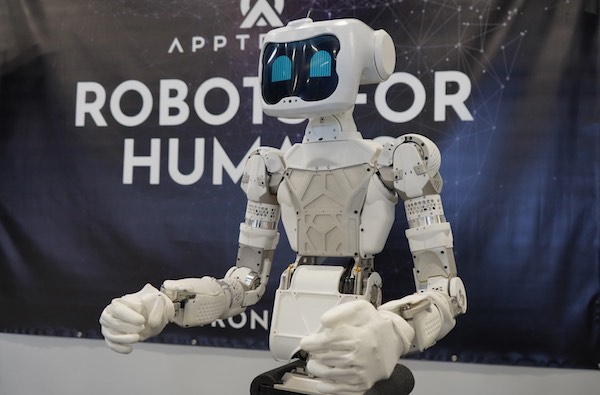General-purpose robots are still the stuff of science fiction, but there's no doubt that automation is becoming part of our daily lives, from vacuum cleaners to fast fulfillment of e-commerce orders. How close are adaptable robots to reality? Apptronik Inc. is developing humanoid models and is watching how the rest of the robotics industry is advancing.
“We're really at an exciting inflection point where robots are becoming more and more useful and expanding the number of people who can gain value,” said Jeff Cardenas, CEO of Apptronik. “They're becoming easier to use and more accessible, doing more and costing less to implement.”
“Public perception is changing—COVID-19 drove a lot of that with job shortages,” he added. “Robotics is key to the future of productivity; there is no future of work without robots.”
Founded in 2016, Apptronik spun out of the University of Texas at Austin. The Austin-based company is developing exoskeletons and the Astro humanoid robot. Cardenas spoke with Robotics 24/7 about how Amazon's recent purchase of iRobot and Apptronik's own work are showing the way to the future of robotics.
Amazon iRobot acquisition an industry bellwether
Amazon is one of the biggest brands in the world, and iRobot is the best-known consumer robotics vendor. What does the acquisition mean in terms of scale and getting robots into people's daily lives?

Cardenas: This is really good for the robotics industry as a whole. For robotics to go to the next level and improve our lives, it will require more investment.
Historically, the venture capital community has been wary of robotics becuse of the initial investment. When we started, people said, “Don't do hardware; it's expensive. Focus on AI.” iRobot pioneered both hardware and software.
Another challenge is that there have been some high-profile failures. One knock we've gotten is, “Where are the acquisitions, the exits?” iRobot pushed the frontier by putting robots in peoples homes as early as it did.
How soon can we expect to see more robots in workplaces and households? What tasks will they be doing?
Cardenas: I think this is part of a natural evolution. Nobody could have predicted what COVID would do to supply chains—that's where robots can help out.
This is largely the beginning. Roomba, which celebrated its 20th anniversary, does one thing. There’s an infinite number of things where robots can help us. Humans are tool makers, and robots are the ultimate tools.
It's a question of how we choose to spend our time. We can build tools that give us back more time. Hopefully, this acquisition is a signal to the market about how important robotics is and its potential to improve our lives.
How does Amazon's purchase of iRobot affect Apptronik specifically?
Cardenas: It has helped create buzz in the industry. We’ve seen an explosion of interest in robotics in the past few years.
We came out of grad school with the DARPA Robotics Challenge. People said, “See you in 20 years,” but that conversation has changed. It's now clear that robotics has tremendous utility and potential value.
Industry should manage expectations
What tasks won't or shouldn't robots do?
Cardenas: I take a long-term view of this. Robots should be doing things that we don’t want to do to free us up for the things we do want to do.
For example, my wife said that if we had a robot to do the laundry, imagine how much time we could save.
There's technological feasibility and a moral imperative. Robots should start with easiest tasks, and they're getting more advanced over time. To appreciate what humans can do, look at highly dexterous manipulation and multi-step complex tasks. Robots can't do them.
Also, robots will create far more opportunities for humans than they’ll take. Nobody knew where the Industrial Revolution would go, but most people don't want to go back to the jobs that existed before it.
What common misconceptions do Apptronik and other service robotics providers still encounter?
Cardenas: Biggest misconception is that people see competition between humans and robots, rather than the possible future of man and machine.
Imagine doing your job without a computer or living life without a mobile device. We’ll look back at robots in much the same way.
We fight against science fiction, which shows what robots could do. People often think robots are far more capable than they are today. However, the reality is that robots are already capabile of doing lots of simpler tasks that can add value. We don’t need robots that can do everything we can do.
Apptronik pursues humanoids
At the same time, Apptronik is working on a generalized humanoid robot. Why that form factor?
Cardenas: It's about space and efficiency. We're trying to build the most versatile system possible, but we've already built the entire world for humans. Since the vast majority of environments are designed for humans, we're building a system that's shaped like us to be useful.
Looking at our business, there's a place for industrial automation and specialized robots as well as general automation. How can we reach where traditional automation can't go? We're moving from structured, highly repeatable tasks to unstructured tasks with robots that are designed to work with and around humans.
Systems with the same morphology can be incredibly useful. We relate and react more easily to humans through nonverbal cues. Apptronik is leveraging that to build systems that people can trust and want to engage with.
What are some of the challenges around such systems?
Cardenas: As we think about general-purpose robots and humanoids as a whole, the technology is more difficult to control. Why go after that if you could do a simpler system? There are three areas to address for general-purpose robots to become more ubiquitous.
The first is affordability. Some people have taken a manufacturing robot and added a camera and AI. However, such robots are built for submillimeter precision and 80,000-hour repeatability. Service robots don't require the same characteristics for general tasks.
We can produce a multi-DoF [degree-of-freedom] system at the same price or less. Instead of trying to get to a certain level of accuracy over time, we can build a 30-DoF robot versus a four-DoF system.
We'll be able to produce humanoid robots for less than industrial robots. We’ve built more than 30 unique electric actuators in a different way toward scalability.
The second challenge is versatility. In addition to a hardware platform capable of a wider range of tasks, you need AI. One example is vision-based grasping. Right now, that's happening in more controlled settings like warehouses.
We're working on how to handle items in more dynamic environments, and the industry as a whole is enabling more versatility. Cognitive AI has a ways to go, but you don’t need it for more utility. You can create a robot form factor to do a range of tasks and expand the range of applications over what was possible five years ago.
Finally, there's ease of use and how to tell a robot what to do. Speaking and imitation learning provide an opportunity and a challenge for companies like like Apptronik. We want to get products into workplaces first, then homes.
The next generation of robots, AI is coming
When can consumers expect to see general-purpose robots and AI? What are some of the remaining technical challenges?
Cardenas: We already have systems out in the world today. That number will only increase over the next five years.
Apptronik is initially focused on supply chain and logistics. Industrial automation has only gotten us so far. Customers still have major gaps, and those are the tasks we’re looking at.
We'll see a dramatic expansion in B2B [business-to-business] markets over the next five years. In five to 10 years, more robots will be introduced to consumers and in the home.
Some technology observers have raised privacy concerns in the case of Amazon-iRobot deal. How can vendors stay on the right side of consumers—and regulators?
Cardenas: A good analogy for this is to think about the smartphone. We used to worry about Big Brother and cameras, and now you have many people across the world today carrying multiple cameras and microphones everywhere they go. They offer such utility that the reward outweighs the risk.
As robotics becomes more useful, this is something that people will accept and make the tradoff for themselves. As they choose robots, the trust in the companies making those systems is paramount. The key is transparency—if people know what you’re going to do with their data, they'll be more likely to trust.
If humanoid robots signal their intent by, say, turning their heads, people will trust their actions. It's all about the utility.
While robotics has grown even as unemployment has been low, how might a recession affect robotics demand?
Cardenas: If you look at data, robotics has typically been countercyclical. Economic contractions typically increase demand for automation. That started in software, and since 2008, that's how it is in robotics. Companies are looking to improve productivity and increase efficiency.
In addition, robotics is key to national competitiveness. With onshoring and reshoring of manufacturing back to the U.S., robots can help address supply chain issues.
We want to build robots that are indispensable. Developers have to build robots that improve the ways people live so it's hard for them to imagine doing their jobs without robots.
The promise of technology has largely been about the idea of time. There were thinkers who predicted a four-hour workweek by the turn of the century. No other technology can deliver that besides automation as a whole.
About the Author
Follow Robotics 24/7 on Linkedin
Article topics
Email Sign Up

















